PRINCETON, NJ -- Consumers' views of the national economy and employees' perceptions of the job market improved slightly last week compared to the prior week, but they remain no better than a month ago. At the same time, consumer spending worsened incrementally last week compared to the prior week and to a month ago.

(Maximum possible value of 200; minimum possible value of -200)
Gallup's Consumer Mood Index improved slightly last week to -55 from -59 the prior week, but remains slightly worse than the -52 score of a month ago. Still, it is much better than it was during the same week a year ago (-113). Consumers' mood seems to have leveled off over the past month as gas prices and interest rates have increased considerably.
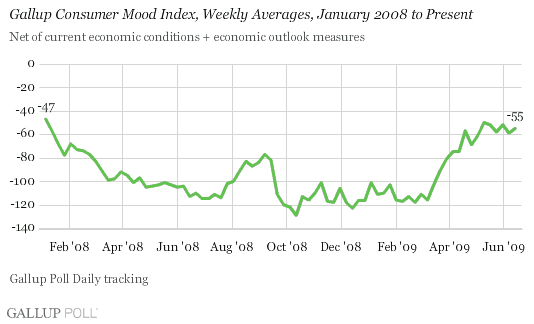
The Consumer Mood Index is based on Americans' answers to two questions regarding current U.S. economic conditions and the economy's direction. Despite the sharp improvement in consumer optimism over the past few months, perceptions of current economic conditions remain much more negative than positive. Only 10% rate the economy as "excellent" or "good" while 47% rate it as "poor," providing a net current conditions score of -37 -- unchanged from the prior week. Similarly, 56% of consumers perceive that the economy is getting worse, compared to only 38% who think it is getting better, for a net outlook score of -18, four points better than a week ago.
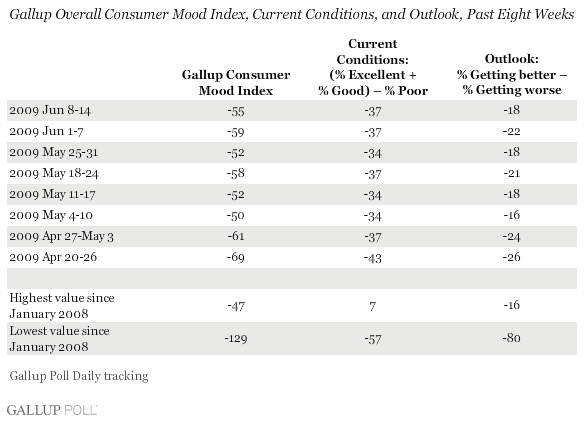
(Unlimited maximum possible value; minimum possible value of $0)
Last week, Americans reported spending an average of $58 per day in stores, restaurants, gas stations, and online -- down slightly from the $63 of the prior week and the $61 average of a month ago. Consumer spending is down 29% from the same week a year ago, when daily spending averaged $82. This represents an improvement from the 48% decline in year-over-year spending reported during the prior week -- but the improvement is the result of a sharp one-week drop in spending comparables for last year. (Gallup's spending data are based on Americans' self-reports of the total amount of money they spent the prior day on purchases other than a home, a motor vehicle, or their normal monthly bills.)
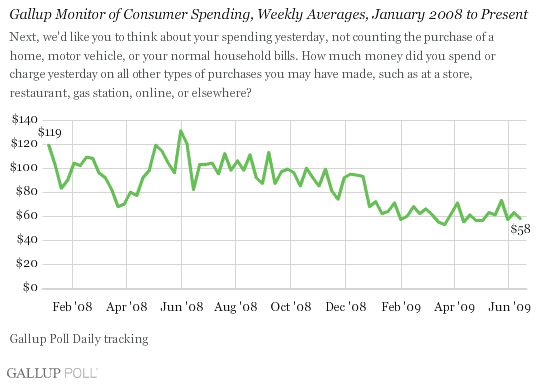
(Maximum possible value of 100; minimum possible value of -100)
Gallup's Net New Hiring Index was at -2 last week, representing a slight improvement from the -5 of the prior week, and is essentially the same as the -3 of the previous two weeks. Job creation edged ahead, with 23% of full- and part-time employees reporting that their companies were hiring -- compared with 22% the prior week. Twenty-five percent reported job reductions at their companies last week, compared to 27% the previous week.
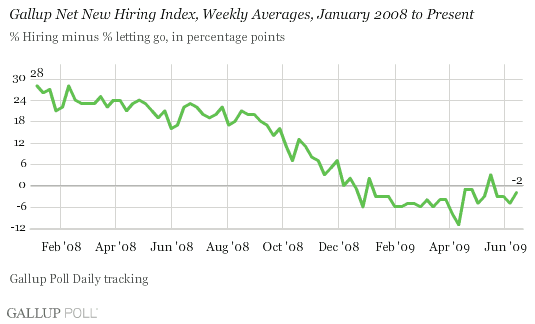
(Maximum possible value of 200; minimum possible value of -200)
The ÆéûÜǨû§Standard of Living Index was 58 during the past week -- essentially the same as the 59 of the prior week and the 57 of a month ago. However, it remains up substantially from 44 a year ago.

The Standard of Living Index is based on two questions -- one asking about respondents' satisfaction with their current standard of living and the other about the perceived direction of their standard of living. Since early April, more consumers have consistently said their standard of living is getting better than that it is getting worse (this week's numbers are 42% and 36%, respectively); and more continue to say they are satisfied with their standard of living (76%) than say they are dissatisfied (24%).
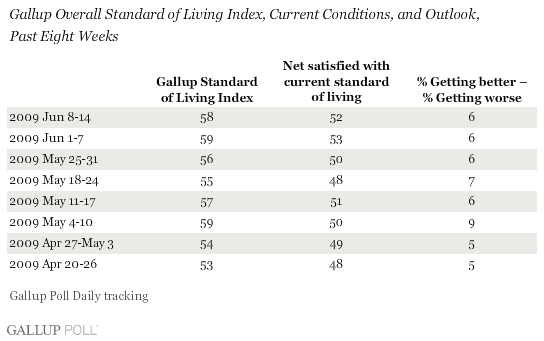
Commentary
Consumers' mood remains near its best level since January 2008, but the surge in optimism that began in March appears to have stabilized over the past month. It seems as though higher gas prices at the pump and higher long-term interest rates overall, as well as the leveling off of the equity markets, may have kept consumer optimism from continuing on the upward trajectory seen in March through May.
Regardless, the sharply improved consumer perceptions of recent months have not translated into a change in consumer spending behaviors. In part, this may be the result of consumers simply waiting to see their hopes that the economy is generally getting better translate into improvements in the Main Street economy. For example, an increase in job creation as opposed to a slowdown in job losses might get consumers feeling better about spending.
On the other hand, today's sharply lower spending levels have persisted throughout the first half of 2009. While some of this might be temporary, it is also quite likely that some of it reflects the "new normal" in spending and saving -- and the new normal in terms of credit availability.
Although the economy seems to have stabilized over the past couple of months, it is not clear whether the potential impact of a "new normal" reduced level of consumer spending has been fully reflected on Main Street. It may soon become apparent whether that is the case unless consumer spending behavior begins to change soon.
Survey Methods
For ÆéûÜǨû§Poll Daily tracking, ÆéûÜǨû§interviews approximately 1,000 national adults, aged 18 and older, each day. Gallup's consumer series includes the ÆéûÜǨû§Consumer Mood Index (evaluating public perceptions about the U.S. economy), the ÆéûÜǨû§Monitor of Consumer Spending (a measure of how much money Americans are spending each day on mainly retail purchases), the ÆéûÜǨû§Net New Hiring Index (a measure of employee perceptions of hiring conditions where they work), the ÆéûÜǨû§Standard of Living Index (evaluating the public's perceptions about its own standard of living), and the ÆéûÜǨû§Consumer Worry Index (a measure of the degree to which Americans are worried about their finances).
The Standard of Living Index is based on questions asked of all respondents; the ÆéûÜǨû§Consumer Mood Index, the ÆéûÜǨû§Monitor of Consumer Spending, and the ÆéûÜǨû§Consumer Worry Index are based on random half-samples of approximately 500 national adults, aged 18 and older, each day. The ÆéûÜǨû§Net New Hiring Index is based on a sample of approximately 250 current full- and part-time employees each day.
The sample sizes and associated margins of error for weekly results for the week of June 8-14 are:
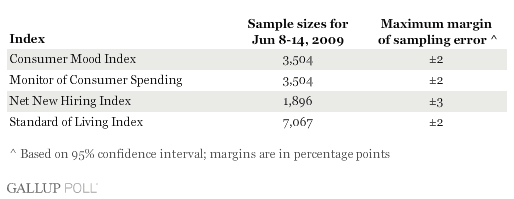
Interviews are conducted with respondents on land-line telephones (for respondents with a land-line telephone) and cellular phones (for respondents who are cell-phone only).
In addition to sampling error, question wording and practical difficulties in conducting surveys can introduce error or bias into the findings of public opinion polls.
